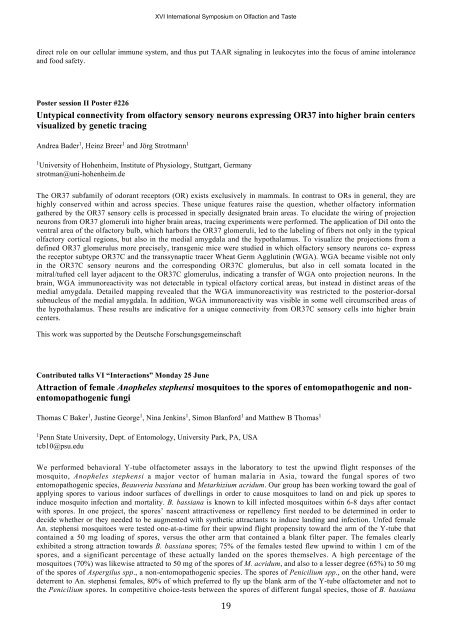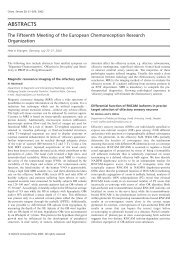XVI International Symposium on Olfaction and Taste - ecro
XVI International Symposium on Olfaction and Taste - ecro
XVI International Symposium on Olfaction and Taste - ecro
You also want an ePaper? Increase the reach of your titles
YUMPU automatically turns print PDFs into web optimized ePapers that Google loves.
<str<strong>on</strong>g>XVI</str<strong>on</strong>g> <str<strong>on</strong>g>Internati<strong>on</strong>al</str<strong>on</strong>g> <str<strong>on</strong>g>Symposium</str<strong>on</strong>g> <strong>on</strong> Olfacti<strong>on</strong> <strong>and</strong> <strong>Taste</strong><br />
direct role <strong>on</strong> our cellular immune system, <strong>and</strong> thus put TAAR signaling in leukocytes into the focus of amine intolerance<br />
<strong>and</strong> food safety.<br />
Poster sessi<strong>on</strong> II Poster #226<br />
Untypical c<strong>on</strong>nectivity from olfactory sensory neur<strong>on</strong>s expressing OR37 into higher brain centers<br />
visualized by genetic tracing<br />
Andrea Bader 1 , Heinz Breer 1 <strong>and</strong> Jörg Strotmann 1<br />
1 University of Hohenheim, Institute of Physiology, Stuttgart, Germany<br />
strotman@uni-hohenheim.de<br />
The OR37 subfamily of odorant receptors (OR) exists exclusively in mammals. In c<strong>on</strong>trast to ORs in general, they are<br />
highly c<strong>on</strong>served within <strong>and</strong> across species. These unique features raise the questi<strong>on</strong>, whether olfactory informati<strong>on</strong><br />
gathered by the OR37 sensory cells is processed in specially designated brain areas. To elucidate the wiring of projecti<strong>on</strong><br />
neur<strong>on</strong>s from OR37 glomeruli into higher brain areas, tracing experiments were performed. The applicati<strong>on</strong> of DiI <strong>on</strong>to the<br />
ventral area of the olfactory bulb, which harbors the OR37 glomeruli, led to the labeling of fibers not <strong>on</strong>ly in the typical<br />
olfactory cortical regi<strong>on</strong>s, but also in the medial amygdala <strong>and</strong> the hypothalamus. To visualize the projecti<strong>on</strong>s from a<br />
defined OR37 glomerulus more precisely, transgenic mice were studied in which olfactory sensory neur<strong>on</strong>s co- express<br />
the receptor subtype OR37C <strong>and</strong> the transsynaptic tracer Wheat Germ Agglutinin (WGA). WGA became visible not <strong>on</strong>ly<br />
in the OR37C sensory neur<strong>on</strong>s <strong>and</strong> the corresp<strong>on</strong>ding OR37C glomerulus, but also in cell somata located in the<br />
mitral/tufted cell layer adjacent to the OR37C glomerulus, indicating a transfer of WGA <strong>on</strong>to projecti<strong>on</strong> neur<strong>on</strong>s. In the<br />
brain, WGA immunoreactivity was not detectable in typical olfactory cortical areas, but instead in distinct areas of the<br />
medial amygdala. Detailed mapping revealed that the WGA immunoreactivity was restricted to the posterior-dorsal<br />
subnucleus of the medial amygdala. In additi<strong>on</strong>, WGA immunoreactivity was visible in some well circumscribed areas of<br />
the hypothalamus. These results are indicative for a unique c<strong>on</strong>nectivity from OR37C sensory cells into higher brain<br />
centers.<br />
This work was supported by the Deutsche Forschungsgemeinschaft<br />
C<strong>on</strong>tributed talks VI “Interacti<strong>on</strong>s” M<strong>on</strong>day 25 June<br />
Attracti<strong>on</strong> of female Anopheles stephensi mosquitoes to the spores of entomopathogenic <strong>and</strong> n<strong>on</strong>entomopathogenic<br />
fungi<br />
Thomas C Baker 1 , Justine George 1 , Nina Jenkins 1 , Sim<strong>on</strong> Blanford 1 <strong>and</strong> Matthew B Thomas 1<br />
1Penn State University, Dept. of Entomology, University Park, PA, USA<br />
tcb10@psu.edu<br />
We performed behavioral Y-tube olfactometer assays in the laboratory to test the upwind flight resp<strong>on</strong>ses of the<br />
mosquito, Anopheles stephensi a major vector of human malaria in Asia, toward the fungal spores of two<br />
entomopathogenic species, Beauveria bassiana <strong>and</strong> Metarhizium acridum. Our group has been working toward the goal of<br />
applying spores to various indoor surfaces of dwellings in order to cause mosquitoes to l<strong>and</strong> <strong>on</strong> <strong>and</strong> pick up spores to<br />
induce mosquito infecti<strong>on</strong> <strong>and</strong> mortality. B. bassiana is known to kill infected mosquitoes within 6-8 days after c<strong>on</strong>tact<br />
with spores. In <strong>on</strong>e project, the spores’ nascent attractiveness or repellency first needed to be determined in order to<br />
decide whether or they needed to be augmented with synthetic attractants to induce l<strong>and</strong>ing <strong>and</strong> infecti<strong>on</strong>. Unfed female<br />
An. stephensi mosquitoes were tested <strong>on</strong>e-at-a-time for their upwind flight propensity toward the arm of the Y-tube that<br />
c<strong>on</strong>tained a 50 mg loading of spores, versus the other arm that c<strong>on</strong>tained a blank filter paper. The females clearly<br />
exhibited a str<strong>on</strong>g attracti<strong>on</strong> towards B. bassiana spores; 75% of the females tested flew upwind to within 1 cm of the<br />
spores, <strong>and</strong> a significant percentage of these actually l<strong>and</strong>ed <strong>on</strong> the spores themselves. A high percentage of the<br />
mosquitoes (70%) was likewise attracted to 50 mg of the spores of M. acridum, <strong>and</strong> also to a lesser degree (65%) to 50 mg<br />
of the spores of Aspergilus spp., a n<strong>on</strong>-entomopathogenic species. The spores of Penicilium spp., <strong>on</strong> the other h<strong>and</strong>, were<br />
deterrent to An. stephensi females, 80% of which preferred to fly up the blank arm of the Y-tube olfactometer <strong>and</strong> not to<br />
the Penicilium spores. In competitive choice-tests between the spores of different fungal species, those of B. bassiana<br />
19



